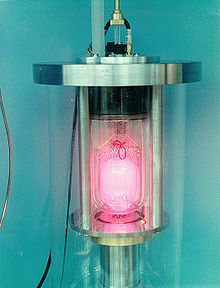Hydrogen maser watch
A hydrogen maser watch is a maser type that uses the specific properties of the hydrogen atom to serve as a highly accurate frequency standard . A distinction is made between active and passive hydrogen measles.
Both the proton and the electron of the hydrogen atom have spins . The atom has a higher energy when both spins are parallel and lower energy when the spins are anti-parallel. The energy required to reverse the electron's spin corresponds to a photon with a frequency of 1,420,405,751.7667 Hertz (Hz) . Exactly the same mechanism is responsible for the creation of the 21 cm line in radio astronomy , in which interstellar hydrogen is the source of radiation.
Hydrogen maser are very complex devices and for about 235,000 US dollars sold.
functionality
In both the active and the passive type, controlled molecular hydrogen escapes from a small storage container into a discharge tube. Hydrogen molecules are made up of two atoms that are linked together. The molecules are split into individual hydrogen atoms by an arc discharge in the discharge tube . This atomic hydrogen passes through a collimator and a magnetic state selector. The atoms are filtered according to the desired state and passed on to the storage flask. The storage flask is made of quartz and measures approximately 20 cm in height and 10 cm in diameter. Its inner wall is coated with Teflon , which prevents the atomic state from changing when it collides with the wall. This slows down the recombination of the hydrogen atoms into hydrogen molecules. The Teflon coating is durable and allows operation for over 20 years. The storage piston , in turn, is located in a microwave resonator made from a precisely manufactured cylinder made of copper or silver-coated ceramic . This cavity is tuned to the resonance frequency of the atom of 1420 MHz. A weak, static magnetic field from a magnetic coil is applied parallel to the cylinder axis to split the magnetic Zeeman levels . In order to suppress the influence of external magnetic fields on the frequency, the resonator is surrounded by several shielding layers.
Active hydrogen maser
In the active hydrogen maser, the cavity itself oscillates. This requires a higher hydrogen atom density and a higher quality factor for the cavity. In high-quality microwave resonators made of silver-coated ceramic, however, the increase factor is much higher, so that a lower hydrogen atom density is required. The active maser is more complex and expensive, but has better short-term and long-term frequency stability. The model CH1 75 of the PTF z. B. has a mass of 90 kg with a power consumption of about 100 W. Its long-term frequency accuracy is about ± 0.5 × 10 −15 in five years. The iMaser 3000 model has better short-term stability of 120 × 10 −15 at one second and a very low phase noise of −130 dBc / Hz at 1 Hz with a 5 MHz reference. The intrinsic frequency drift is 0.7 × 10 −15 per day, even without automatic adjustment of the cavity. When used as a clock, this is a deviation of 1 second in 63 million years. Network technology makes it easy to monitor, control and maintain a new generation of active masers.
Passive hydrogen maser
With the passive hydrogen masher, a frequency of 1420 MHz is radiated into the cavity from an external source. The external source is tuned for maximum response. This allows a lower hydrogen atom density and a lower quality of the resonator and thus lower costs. The model CH1 76 of the PTF has a mass of 55 kg with a power consumption of around 90 W. Its long-term frequency stability of ± 1500 × 10 −15 per year is much worse than that of active measles.
literature
- A. Bauch: Metrology and Fundamental Constants . Ed .: Theodor W. Hänsch , S. Leschiutta, AJ Wallard. Course CLXVI. IOS Press / Società / Italiana di Fisica, Amsterdam / Bologna 2007, ISBN 978-1-58603-784-0 , Atomic frequency standards, properties and applications, p. 303–308 ( limited preview in Google Book Search [accessed April 8, 2010]).
Individual evidence
- ↑ Time and Frequency from A to Z: H . In: Physics Laboratory . National Institute of Standards and Technology . Hydrogen burl. Archived from the original on May 14, 2010. Retrieved April 6, 2010. (English)
- ↑ Symmetricom MHM 2010 Data Sheet (PDF; English)
- ↑ a b c d e iMaser 3000 . Accessed April 8, 2010. (English)
- ↑ Hydrogen Masers USNO (English)
- ↑ Patent US5838206 .
- ^ Laurent-Guy Bernier, Swiss Federal Office of Metrology and Accreditation: Predictability of a Hydrogen Maser Time Scale . In: 19th European Time and Frequency Forum Besançon . March 2005, p. 438–441 (English, t4science.com [PDF; accessed on May 8, 2010]).
- ↑ CHI-75 Active Hydrogen Maser Data Sheet ( Memento from October 30, 2013 in the Internet Archive ) (PDF; English)
- ↑ CHI-76 Passive Hydrogen Maser Data Sheet ( Memento from October 30, 2013 in the Internet Archive ) (PDF; English)
